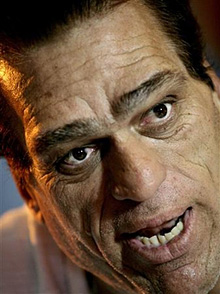 |
 |
 |
 Entertainment | May 2007 Entertainment | May 2007  
Real-Life Violence Turns Mexico Off Drug-Lord Films
 Greg Brosnan - Reuters Greg Brosnan - Reuters


| | Mexican actor and director Rumaldo Bucio, whose stage name is Agustin Bernal, speaks during an interview about his B movies which once idolized ultra-violent drug lords in Mexico City May 22, 2007. Bucio, famed for portraying trigger-happy villains in home-grown films such as 'Narcos of Death' said growing disgust at increasingly violent traffickers had forced him to stop making films about them. Picture taken May 22, 2007. (Andrew Winning/Reuters) |
Once popular B-movies idolizing violent drug lords are dying out in Mexico as the horror of a real-life cartel war strips the genre of its glamour.

Mexican actor and director Rumaldo Bucio, famed for portraying trigger-happy villains in home-grown films such as "Narcos of Death" said growing disgust at increasingly violent traffickers had forced him to stop making films about them.

"Drug traffickers were seen as gods; they were idolized," said Bucio, better known by his stage name Agustin Bernal. "Not any more, people are shunning all this in movies and real life."

President Felipe Calderon has sent thousands of troops to fight competing cartels in a three-way war of unprecedented violence that has killed over 900 people this year. Drug gangs have used parts of Mexico as dumping grounds for corpses and severed heads of rivals.

Now made largely for DVD release, the ultra-violent films, typically with budgets around $100,000 or less, reached their peak in the 1970s and '80s when they were popular on Mexican television.

But Mexicans now have a wider range of home entertainment, and are put off the genre by real blood and guts pushed in front of them in newspapers and on nightly news bulletins.

"We watch these films every night in little pieces," said columnist and cultural commentator Guadalupe Loaeza. "For months we've been immersed in these horrible scences."

Almost daily, traffickers tape up victims' mouths and noses, leaving them to suffocate in agony and last year even tossed the severed heads of five rivals onto a dance floor. A gunfight last week near the U.S. border killed 22 people.

Bucio said the level of violence made his films look tame.

"We've beheaded two or three people in films, cut off a head, thrown it away or sent it to someone in a box," he said. "But these guys have gone too far."

A towering 48-year-old former soldier who does all his own stunts and wears a wild boar's tusk on a chain around his neck, Bucio grew up in the Pacific state of Michoacan -- the bloody center of the war against the cartels.

He hopes to capitalize on his celebrity status to run for mayor for a leftist party later this year in his home village of Paracuaro, near where drug hitmen killed five soldiers three weeks ago in a shootout.

Bucio says he has seen drug money turn local hamlets of cardboard houses into bustling towns brimming with mansions. Admiring cartel chiefs often ask to have their photograph taken by his side.

He is pessimistic that the violence will end soon.

"It's out of the authorities' control and it's out of (the traffickers') control," he said. "It's like gangrene, like cancer, when it spreads through your body what can you do?" | 
 | |
 |



